Special Feature: Products Sally Recommends
Adventures in the Arabian Gulf
The Marriott Hotel in Dubai is one of the most user-friendly, comfortable and truly luxurious 5-star hotels one could wish for. The Steakhouse there serves what are arguably the best steaks in the whole Gulf region, and its Italian restaurant, "Cucina" is so good that the Marriott group has decided to clone it into some of its other international properties. The Dubai Marriott is just one of the many outstanding new-generation places-to-stay in the Gulf region.
In the spacious lobby I overhead a conversation between some German tourists (that's the advantage of having a couple of extra languages up your sleeve). They were saying how much they were enjoying their stay in Dubai and how surprised they were at just how much there was to see and do. I smiled a quiet smile. I've been down that road myself from the first time I came to this city.
If you expect Dubai to be the sort of ancient, mysterious and just slightly dangerous place portrayed in 1950s Peter Lorre films, forget it. Instead, expect a sophisticated, ultra modern city with every possible "mod-con," a spirit of genuine friendliness without any hard-line extremism whatsoever, and a determination to do things better in every way.
An perfect example of this flight to quality is seen in Emirates, the international airline that Dubai has built from a small regional carrier to the stage where it has become a much-admired pacesetter airline that services Europe, Asia, Australia, Africa, and, through an alliance with United, USA (until, in the not too distant future, it will operate that route itself).
The man behind Emirates, Sheikh Ahmed bin Saeed Al Maktoum, was first educated in England and then gained his MBA from the Harvard Business School. He set out from the beginning to take every possible award with his new airline.
How well he has succeeded is obvious from the traveler polls -- 130 international awards which include three "Airline of the Year" titles (by readers of UK's Executive Magazine, readers of Germany's Reise & Preise Magazine and Germany's Globo Magazine). Anyone who has traveled on Emirates, the first airline in the region and one of the first in the world to operate the new Boeing 777's, and experienced the sort of service this outstanding airline provides, will know the reason for this galaxy of accolades.
Like many of the other corporations in Dubai, the airline will hire only the very best people available, regardless of where they come from or what they have done before. It is this attitude that, also applied to other aspects of Dubai, gives the city some of the finest architecture in the Middle East, superb restaurants, and a spirit of "can-do" that is the envy of many other countries in the region.
Because of its position as a bridge between Asia and Europe, Dubai has historically been a true melting-pot of cultures. Her trading dhows brought silks, spices, tea and other products from Asia to continue their journey to Europe by ship and camel-train. They returned with manufactured goods bound for the Indian sub-continent, China and South-East Asia. In the process, the Arabian traders from the Gulf area also took Islam to what is now Pakistan, Malaysia and Indonesia.
Today, guest workers from these and many other countries can be found manning oil rigs, operating computers, working on building sites and in shops -- in fact, helping to staff the operation of every imaginable kind of commercial and administrative organization. European expats are also heavily involved in corporate management here.
An English expatriate executive told us that people from 123 different countries are registered as living in Dubai. All add their expertise, and the authorities are remarkably receptive to the new ideas and modern methods that their companies espouse. Once a sleepy fishing and trading settlement, Dubai first exported oil in 1969. Since then it has been transformed into a dynamic, cosmopolitan, diversified and multi-faceted Emirate.
 From our first drive through downtown Dubai, we couldn't help noticing the similarity with this city and Singapore in architecture, layout and cleanliness. As in other modern Gulf cities, most Dubai buildings are new, and with leading-edge design and architecture. And while the lush tropical vegetation is missing, the wide, well laid-out streets, and the amazing plantings come as a real surprise, and a pleasant one at that. They are very effectively drip-watered to provide unexpected greenery, and are kept spotless and litter-free by a combination of severe fines for litter-bugs and eagle-eyed cleaners who quickly get rid of what little offending trash is about.
From our first drive through downtown Dubai, we couldn't help noticing the similarity with this city and Singapore in architecture, layout and cleanliness. As in other modern Gulf cities, most Dubai buildings are new, and with leading-edge design and architecture. And while the lush tropical vegetation is missing, the wide, well laid-out streets, and the amazing plantings come as a real surprise, and a pleasant one at that. They are very effectively drip-watered to provide unexpected greenery, and are kept spotless and litter-free by a combination of severe fines for litter-bugs and eagle-eyed cleaners who quickly get rid of what little offending trash is about.
To see how people used to live here, our guide Ali took us to the small area which is all that is left of "Old Dubai." Extremely atmospheric, and with small lanes fronting walled-houses with secret courtyards, we saw the wind-towers which were so much a part of this city's old architecture. "The world's first air-conditioning," Ali commented, going on to explain that these towers were cleverly designed to catch the wind and funnel the breeze down into the living-quarters.
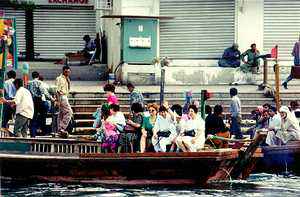 Then it was time for a water-taxi across "The Creek," (actually it's not a creek at all, but a waterway that cuts off a former peninsula and makes an excellent sheltered harbor for dhows and larger ships). As we waited for the next ferry, I noticed a poorly-dressed man sitting at a small folding table laden with cheap Russian-made watches, cameras, and the sorts of calculators that companies like Sony and Canon would have considered obsolete ten years ago.
Then it was time for a water-taxi across "The Creek," (actually it's not a creek at all, but a waterway that cuts off a former peninsula and makes an excellent sheltered harbor for dhows and larger ships). As we waited for the next ferry, I noticed a poorly-dressed man sitting at a small folding table laden with cheap Russian-made watches, cameras, and the sorts of calculators that companies like Sony and Canon would have considered obsolete ten years ago.
"Russian," said Ali almost under his breath. "Some of them come here without cash, but loaded up with this sort of junk. They come to the other Emirates as well, and you no doubt heard that one of their planes crashed there very recently. They'd find it hard to convince a sophisticated buyer that the stuff was worth having. But it's right up the alley of poor Pakistani and Bangladeshi laborers who can't afford anything better. With the money the traders get, they buy up-to-date electronics gear and go back to Russia."
But we heard that there is also a more tacky side to the Russian "invasion." Many of the Russian women who came here for trading were also quite prepared to offer themselves, and again found a ready market among Dubai's poorer laborers who, for $8 a time, thought it a novelty to sleep with a middle-aged woman built like an Olympic weight-lifter. Some of the Emirate governments were so perturbed by the increasing frequency of this impromptu prostitution that they have instructed hotels and boarding houses not to let rooms to single women from the former USSR.
As we crossed The Creek we watched the passing water traffic and saw the stunning architecture of the buildings along the waterfront. Perhaps the most striking of these was the Post and Telegraph office, surmounted by a huge round ball. "That contains some of the most modern satellite communication systems" we were told with pride. "The concept is so efficient and looks so good that other Emirates have copied it from us, much to the annoyance of our Government's Post and Telegraph service."
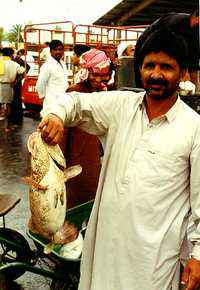 We were enthralled with our visit to the Fish Market. There were fish on stalls, and fish in buckets, fish steaks, fish slices and unrecognizable fishy bits. Fish was being sold off the back of pick-ups, and there were plenty of buyers. And no wonder! The 129 varieties of edible fish that are found in the waters of Dubai looked marvelous -- big, healthy and very clearly just-caught, with many still flapping away. Remember all that hype from the Gulf War when we were told that the marine life of the Gulf would be wiped out by the oil-spills? We have good news for the Cassandras who made those predictions. Judging by the large healthy-looking fish we saw, the announcement of the demise of their species was highly exaggerated.
We were enthralled with our visit to the Fish Market. There were fish on stalls, and fish in buckets, fish steaks, fish slices and unrecognizable fishy bits. Fish was being sold off the back of pick-ups, and there were plenty of buyers. And no wonder! The 129 varieties of edible fish that are found in the waters of Dubai looked marvelous -- big, healthy and very clearly just-caught, with many still flapping away. Remember all that hype from the Gulf War when we were told that the marine life of the Gulf would be wiped out by the oil-spills? We have good news for the Cassandras who made those predictions. Judging by the large healthy-looking fish we saw, the announcement of the demise of their species was highly exaggerated.
By this time we were more than ready for a late lunch at "Al Boom," an unusual restaurant housed in a large Arabian dhow permanently moored along the bank of The Creek. The main deck had been covered over so that it was delightfully shady, the buffet platters of seafood looked fresh and tempting and judging by the number of businessmen, both Arab and Western dining here, Al Boom was a booming success.
The afternoon was dedicated to exploring why stopovers in Dubai have become so popular so we headed for the busy wholesale and cut-price electronic shops in the suburb of Deira.
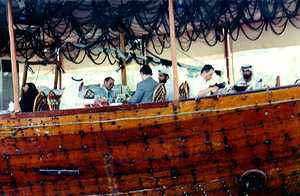 Immediately, I couldn't help noticing more Russians. In the hodgepodge of nationalities one sees in Dubai's shopping streets at Karama and along Al Burj Street in the Deira district, they are noticeable by their 1960's country-style clothing, their stocky figures and the peasant-scarf-covered heads -- as well as the huge shopping bags they invariably carry. Over the last year, it has almost become a national pastime for entrepreneurially-minded citizens of the former USSR to go to Dubai to shop.
Immediately, I couldn't help noticing more Russians. In the hodgepodge of nationalities one sees in Dubai's shopping streets at Karama and along Al Burj Street in the Deira district, they are noticeable by their 1960's country-style clothing, their stocky figures and the peasant-scarf-covered heads -- as well as the huge shopping bags they invariably carry. Over the last year, it has almost become a national pastime for entrepreneurially-minded citizens of the former USSR to go to Dubai to shop.
Day after day, Aeroflot and the airlines of the new Russia, Ukraine, Kazakhstan and other Eastern European areas bring hordes of shoppers who return home laden with electronics and housewares. "They're an absolute pest," our driver Ali muttered contemptuously. "Once when we wanted to buy a TV or computer we could bargain for half an hour, drink two cups of tea and finally settle on a price. But now the shop-keepers don't care about coming down too far for us locals. They know that the Russians will clean out their stock anyway."
While they win no popularity polls with locals, the Russian presence does prove that Dubai is a remarkably good place to shop. But not all categories of merchandise will be interesting to the international shopper. Clothing, for example, is a definite no-no in Dubai. The expensive luxury shopping malls like the Al-Ghureir Center on Al-Riqua Road do stock designer names, but have very limited selections and styles and at prices you could probably better in New York, Paris, Singapore, Los Angeles or Sydney. But there are other very worthwhile things to buy in Dubai.
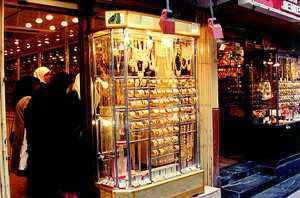
Gold jewelry is an outstanding bargain and plays a very important part in the life of Middle Eastern women. While the men drool over new cars, fast horses and the latest electronics, the women like to possess gold -- in the form of heavy necklaces, bracelets or earrings. And the Souk (oriental market) has them -- by the thousand.
Shop after shop was choc-a-bloc with row after row of gold ornaments for every purpose. It was interesting to see that all the gold in any one shop was usually of the same carat rating throughout. Shops on the ground floor generally had the purest gold and the highest prices, and as we went to the second and third floors, the carat ratings and price tags dropped in unison.
With computers and computer parts, prices were keen in spite of the Russians. We saw excellent deals on electronics and cameras (though I suspect you would do better still in the discount stores of New York's Borscht belt) and luckily had the exact details of what we needed. The local computer sales staff didn't seem to have a clue about the technical aspects of the items they were selling. For those who know exactly what they want, and have checked on the best prices before leaving home, selective shopping in Dubai can pay for a large portion of the ticket.
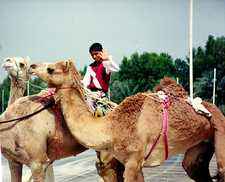 Next day was full of adventures and unexpected sights. We were heading for the magnificent race-track where the richest horse race in the world is now a regular event, and on the way called in to see the camel race-track with its graceful Arabian tent-like Club house. Here I noticed that the camel jockeys were young boys in their early teens, sitting precariously on the rear-sloping rump of stately tall beasts that dwarfed these youngsters. How could they possibly stay on the camels during a race?
Next day was full of adventures and unexpected sights. We were heading for the magnificent race-track where the richest horse race in the world is now a regular event, and on the way called in to see the camel race-track with its graceful Arabian tent-like Club house. Here I noticed that the camel jockeys were young boys in their early teens, sitting precariously on the rear-sloping rump of stately tall beasts that dwarfed these youngsters. How could they possibly stay on the camels during a race?
"Lots of these boys used to fall off the camels and get hurt," our driver Ali explained with a smile. "And it was really starting to become a big worry. Then someone had the great idea to use velcro. Now they stick large patches of this onto the camels back and sew matching velcro patches onto the jockey's leggings. It's been amazing! The attendants peel the jockeys off the camels after each race and there hasn't been an accident since". This was just one of the many intriguing, sometimes funny, and interesting facets of our Dubai stopover.
Like most travelers from the Pacific region, we had often passed through Gulf State airports on the way to Europe and, not being crazy about the high 40 degrees C summer temperatures encountered during those earlier refueling stops, had never considered a stop-over there. But this time was different. Winter in Dubai proved to be ideal with sunny 25 degrees C days.
Between late October and end-March the Arabian Peninsula enjoys a temperate climate and -- the last thing I had expected -- occasional rain-storms.
From the first day, it was obvious that the Government here, unlike some other countries in the region, is remarkably tolerant and flexible. For example, we were surprised to see female executives in various places -- banks, hotels and at the airport -- and were told that this was not unusual in Dubai. What a contrast to Saudi Arabia, where women are not even allowed to drive cars, and must work on different floors to men in organizations such as banks. A lot of people think that all countries in the Arabian Peninsula are similar, but that is about as simplistic as saying that all European countries are the same.
Our driver knew the deserts, mountains and oases around Dubai like the back of his hand. We had heard about the local motoring masochists who risked vehicle and sanity by indulging in a sport called "dune bashing." Get it wrong, and you quickly find yourself stuck radiator-deep in the sand. Now he would show us how it's done. Our seat-belts were well and truly fastened, and the adrenalin was flowing full bore. "Hang on tight," he said, "the fun's about to begin."
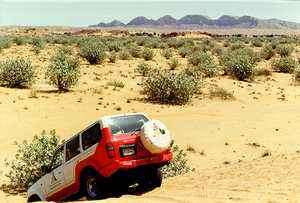
With engine revving, the Landcruiser picked up speed and approached the insurmountable-looking sand-dune in front. The vehicle tilted as it began climbing the almost-vertical dune which curved up at an intimidating angle and vanished on a razor's edge. On the verge of stalling, we hit the top, pushed through the sand-ridge at the edge, and suddenly tipped forward quite violently as we raced downhill, picking up speed and headed for the next dune.
This is "Dune Bashing" -- Dubai-style -- an exhilarating pastime needing an enormous amount of judgment, skill and experience to make sure that each dune is approached at exactly the right speed and at the right angle. It's definitely not a sport to try on your own.
Casually, after our dune-bashing experience, our driver asked us whether we had ever tried skiing on sand. Skiing on sand? We wondered if the sun had got to him and said as much. "No it's true, it can be done, but it's very fast -- so much so that you have no chance of changing direction. You just go to it, and it's over almost before you start. Watch me!" He took a short skateboard-sized ski out of the back of the vehicle and climbed up a nearby sand dune.
With the "ski" buckled on, he tipped the board forward. Suddenly he was rocketing down the dune at breakneck speed. No way could he turn that skateboard sideways! It was all going too fast. Stopping gracefully at the bottom of the hill, he called out to me if I wanted to give dune-skiing a try. I tried to chicken-out with as much decorum as possible. Like surfing on a dumper wave, it looked great -- as long as I didn't have to do it!
We resumed our journey and noticed that the land was becoming hilly. Now and then we came across an oil rig testing new holes, and oil pumps nodding away at their own leisurely pace like mechanical giraffes.
"I thought we'd have lunch at an oasis," our driver said, and I wondered what would follow. I had seen oases in China's Gobi desert that that turned out to be cities of a million inhabitants, but had always imagined an Arabian oasis to be two palm trees, a camel and a well ever since my first childhood story-book had illustrated one in that manner. Once again pre-conceived ideas were to be bound for the scrap-heap.
As we made our way down a narrow valley, the hills changed color and became more rugged. The narrow ravine was only just navigable by our 4-WD as small pools of water and grassy tussocks began to appear.
The ravine widened, with shrubs and palm trees edging the track. And suddenly there it was! -- a small fissure between two rocks where pure crystal-clear water was welling out. It bubbled and gurgled over the rocks, finishing in a pool so clear that it might have been made of glass.
In it, small fish -- (wherever would they have come from?) -- darted hither and thither. Returning to the Landcruiser I picked up a small piece of bread and dropped fingernail-sized pieces into the water. For a moment the surface boiled with little fish, then the bread was gone, the fish heading back under rocks and between stones. It would have been hard to imagine a more idyllic picnic site.
The afternoon had passed quickly, and we headed back for Dubai city via the Jebel Ali industrial zone. The amount of industry we saw there was yet another surprise. I had expected Dubai to have a purely oil-driven economy, so the huge industrial complex was an eye-opener. Businesses ranging from Japanese electronics firms to Germany's Bosch have their home among the 600 different organizations that had set up operations here. The biggest plant was a huge aluminum works, and the recycled water from its industrial process was put to a good, if unexpected use on the golf courses, another minor miracle that has to be seen to be believed.
We had been driving along a newly-built highway lined on both sides by a forest of cranes that were constructing housing blocks and medium-rise offices wherever one looked. But the building sites were sandy desert, with not a tree or blade of grass in sight. And then, in the distance, a mirage of emerald lawn came into view -- the manicured greenery, shimmering lakes and imaginative white tent-like club houses of the Emirates Golf Club.
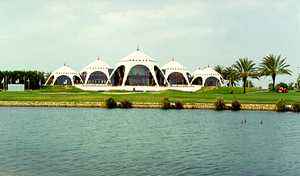
The 172-acre world-standard golf course with fish-filled lakes and palm-edged fairways is now on the European PGA circuit, has seen names like Ballesteros, Woosnam, Faldo, Rafferty, Norman and Darcy competing for rich prizes. There is also the equally-stunning Dubai Creek Golf & Yacht Club and the floodlit 9-hole Dubai Golf and Racing Club. During hot weather, night golf on floodlit courses is a popular and pleasant alternative to day-time playing. These courses have made Dubai a golfer's paradise and any Dubai hotel's concierge can always arrange a game for visitors.
We spent the next day out of town at Hatta. This ancient village, set at the foot of the Hajar Mountains, is timeless. Scattered around the valley are age-old stone towers being meticulously restored to their original late-1700's condition. And breaking the spell of this timeless place are a number of palatial weekend homes set inbetween the village houses. The owners are clearly multi-millionaires from the city.
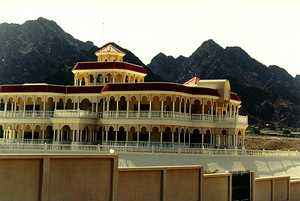
At Hatta, we discovered the Hatta Fort Resort, a remarkable get-away from the hustle and bustle of the city. This modern and comfortable vacation spot is a favorite of locals and expatriates alike. Its large swimming pool had a feature I had not seen in other places. Music was piped into the water in such a way that I couldn't hear it when my ears were not submersed. But as soon as they were, the piped music came through softly but clearly. It was a great place for an overnight stop.
On the way back we saw more evidence of what a little water could do to turn desert into oasis. At one spot a small area of wilderness had been cultivated and a farmer was growing the biggest, healthiest-looking tobacco plants I'd ever seen. Modern greenhouses lined another section of the road leading back into the city. I asked our driver what was growing under the glass. "Strawberries," he replied with a grin. "When it's mid-winter in Britain we air-freight strawberries to their supermarkets by the plane-load."
Our final impression of Dubai was of the superb duty-free shop at the airport -- a chance to buy that last minute gift -- another shopper's dream, with prices that were sometimes 40% lower than we had seen for the same items in European and American airport duty-frees.
Next time you plan to fly via the Gulf around end-year, try a stopover there. You won't be disappointed.
![]()
Getting there
We would recommend Emirates from Europe, Asia or Australia, and a British Airways/Emirates or United/Emirates combination from the US east coast. From the west coast, Air New Zealand to Melbourne and then onward by Emirates, or Singapore Airlines to Singapore and then Emirates on to Dubai are great combinations that allow multi-faceted stopovers on the way.
Best time to go
Unless you really love the heat, October to April are the best months for visiting the Gulf.
Security
Dubai is one of the safest places one can imagine.
Currency
Take American Dollar or UK Pound or Deutsche Mark travelers checks. The usual credit cards are also widely accepted.
Where to stay
Marriott, Hyatt, Sheraton, Intercontinental or any of the other 5-star hotels in Dubai are perfect. Standards are exceptionally high.
![]()
Walter & Cherie Glaser are an international travel-writing team based down under in Melbourne, Australia.
Note: This information was accurate when it was published. Please be sure to confirm all rates and details directly with the businesses in question before making your plans.



